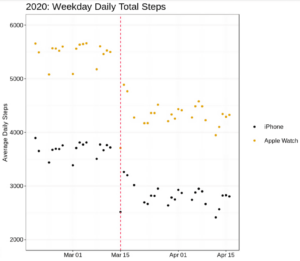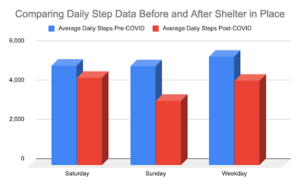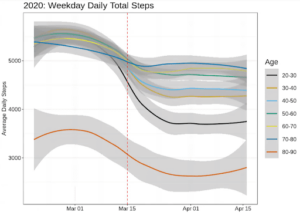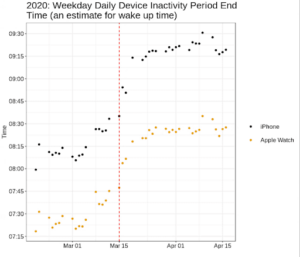The COVID-19 pandemic has changed everything: from how we work, learn, and interact, to how active, or inactive, we are each day.
 Less Walking
Less Walking
People are walking a lot less and sleeping more since efforts to slow the spread of COVID-19 began in March, according to new data compiled by 23andMe. Researchers looked at data from 33,000 individuals, who consented to participate in research, and included about 20 million data points tracking more than two months of activity. While we know the virus itself presents serious health risks, these changes in daily behavior may also impact our health in more subtle ways.
“It really comes down to the small everyday things; the commute to work, dropping the kids at daycare or school, the grocery store runs, the walk to get lunch,” said Teresa Filshtein Sonmez, Ph.D., a 23andMe Research Biostatistician, who is a part of the team looking at the data. “All the small everyday physical actions we take add up.”
Disrupting Routines
Teresa noted that while we are sheltering-in-place, we are not doing those things.
“We know the pandemic is disrupting our lives, but we also want to understand how these changes may affect our health,” she said. “We want to understand COVID-19 and the impacts it has, from every angle (not just the genetic one!); e.g., what is the ‘health cost’ of 1000 less steps a day? ”

Since U.S. residents first began sheltering in place, the daily number of steps taken on average dropped by 22 percent, according to 23andMe’s data. (See Figure 1.) This data came from customers who have consented to participate in research and are sharing data from either iPhones or Apple Watches. The observed pattern is even more striking on weekends. (See Figure 2.) For example, since shelter-in-place policies were enacted, the average number of steps taken on Sundays decreased by about 35 percent. In comparison, during the same period in 2019, the number of daily steps actually increased, likely due to better weather and longer spring days.
Differences between Groups
The 23andMe analysis also compared step data across genders and age groups. While we did not observe substantial differences between men and women, the age patterns told a different story. Grouped by age, we found that activity declined within each age group, but for younger individuals, this reduction in activity was especially profound. Before the shelter in place orders, people in their 20s – 40s had the most steps, but since mid-March, the physical activity patterns have reversed– with the people in their 20s experiencing the most drastic decrease. (See Figure 3.)

Figure 3. Step totals by age group before and after shelter in place orders.
The sleep data is a little more challenging to understand because our data come from smart devices rather than sleep trackers. Specifically, we know how long each device has been inactive at night. From that data, we can see that device inactivity increased by about an hour and a half (+12%) during the week. When we dove a little deeper into the device inactivity period, we saw that this extra 1.5 hours of inactivity was restricted to the morning. (See Figure 4.) In other words, compared to pre-COVID behavior, people seem to be putting their devices down for the night at approximately the same time, but they are starting their days (or initiating device use) a little bit later each day. While device inactivity is not a direct measure of sleep, our data show a substantial change in our customers’ behavior.
 Parents and Families
Parents and Families
Sheltering-in-place has not only transformed the lives of adults, confining most of us to working from home but has also led to the closures of most schools and daycare centers. To explore how these changes affected parents’ activity levels, we compared both daily steps and average wake-up time across individuals with and without children living at home.* We observed that COVID-related physical activity changes were more dramatic for individuals without children, especially among men.
On average, in the two weeks since the shelter-in-place ordinances, men without children walked 26% less than in the preceding two weeks, while men with children only reduced their step count by 10%. Similarly, women without children had a step reduction of 25%, compared to only 20% for mothers. In addition, the median change in the wake-up time for men without children was about 25 minutes greater than it was for fathers. However, we saw only a slight change in this same measure among women. While this could be explained by women sleeping more, it is also possible that women just pick up their devices later in the morning. In fact, other studies by 23andMe scientists have explored gender differences in activity vs. phone use behaviors.
Other Published Data
Our findings are consistent with other published evidence on the far-reaching effects of the COVID-19 epidemic. Fitbit– a fitness tracker manufacturer– recently published data showing that in early March, the number of average steps taken by their millions of users has dropped by between 7 percent and 38 percent, depending on the country. Predictably, the largest decreases were in countries suffering the most serious outbreaks, like Spain and Italy. For the U.S., the activity changes reported by Fitbit were modest compared to 23andMe’s data. However, Fitbit only considered data from one week in March whereas 23andMe examined several months’ worth of activity patterns.
This small sampling of the data shows just how much the pandemic has disrupted people’s lives. These changes in activity and sleep may have a lasting health impact that is not captured by infection rates but can compellingly be attributed to the pandemic.
*This analysis was limited to participants in the 20-50 age group.



